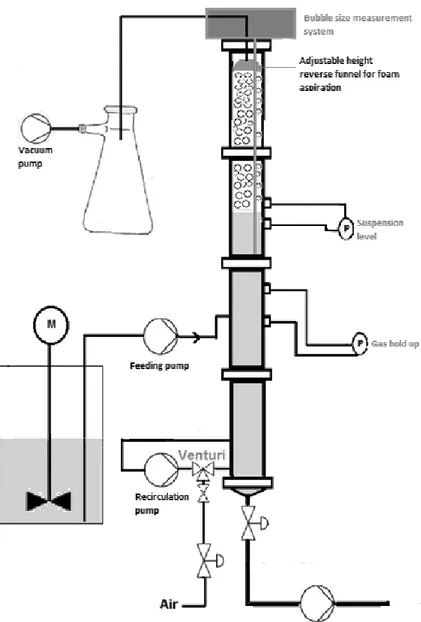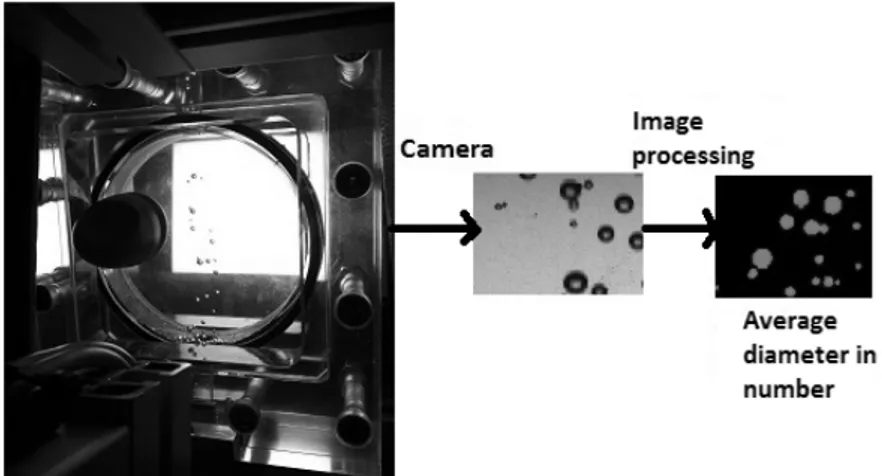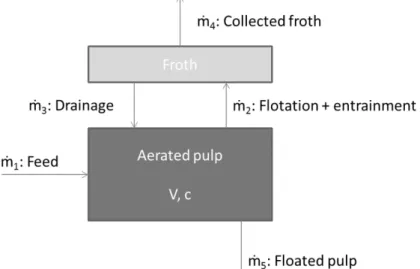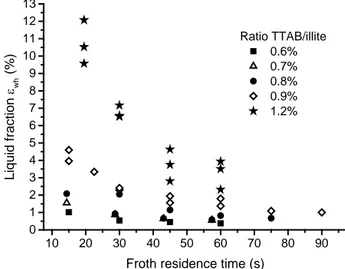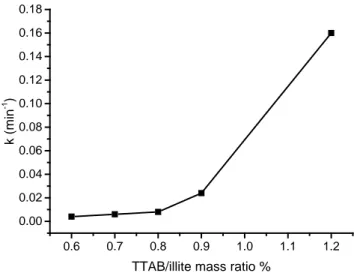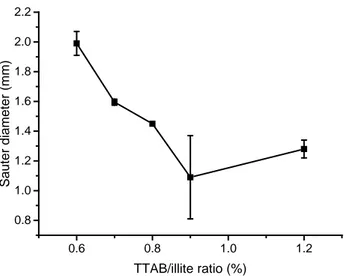HAL Id: cea-02438718
https://hal-cea.archives-ouvertes.fr/cea-02438718
Submitted on 28 Feb 2020HAL is a multi-disciplinary open access archive for the deposit and dissemination of sci-entific research documents, whether they are pub-lished or not. The documents may come from teaching and research institutions in France or abroad, or from public or private research centers.
L’archive ouverte pluridisciplinaire HAL, est destinée au dépôt et à la diffusion de documents scientifiques de niveau recherche, publiés ou non, émanant des établissements d’enseignement et de recherche français ou étrangers, des laboratoires publics ou privés.
Soil remediation after radioactive contamination Study
of illite clay extraction by dispersed air flotation in a
new instrumented column
J. Chapelain, J. Mascarade, D. Curtil, S. Faure, D. Beneventi
To cite this version:
J. Chapelain, J. Mascarade, D. Curtil, S. Faure, D. Beneventi. Soil remediation after radioactive contamination Study of illite clay extraction by dispersed air flotation in a new instrumented column. Flotation 2016 - 7th International IWA Conference on Flotation for Water and Wastewater Systems, Sep 2016, Toulouse, France. �cea-02438718�
Soil remediation after radioactive contamination: Study of illite clay extraction by dispersed air flotation in a new instrumented column
Julie C. M. Chapelain1,2, Jérémy Mascarade1, Denis Curtil2,4, Sylvain Faure1, Davide Beneventi2,3,4
1 CEA, DEN, DTCD, SPDE, LPSD Marcoule, F-30207 Bagnols-sur-Cèze, France (Email:
julie.chapelain@cea.fr, jeremy.mascarade@cea.fr, sylvain.faure@cea.fr)
2 Univ. Grenoble Alpes, LGP2, F-38000 Grenoble, France (Email:
Davide.Beneventi@pagora.grenoble-inp.fr, Denis.Curtil@pagora.grenoble-inp.fr)
3 CNRS, LGP2, F-38000 Grenoble, France 4 Agefpi, LGP2, F-38000 Grenoble, France
ABSTRACT
A new instrumented flotation column that is halfway between the pilot and the lab scale is presented. This installation works in continuous mode and allows both bubble size distribution and gas hold up measurement in the slurry. In the present study, it was used in the context of clay extraction. The final objective was to employ this flotation process for radioactive soil remediation. Data were interpreted using a two-zone model based on mass balance. A cationic surfactant (TTAB) is able to adsorb on the negatively charged clay particles surface and modifies the hydrophobicity to different extents depending on the employed TTAB quantity. We looked at the influence of TTAB/clay mass ratio on flotation performances, bubble size distribution and gas hold up. Consistent and reproducible data were obtained. The flotation rate constant increases with the TTAB/illite ratio whereas bubble size decreases. Gas hold up measurements underlined an accumulation of small bubbles at the highest TTAB/illite ratio tested due to their small buoyancy.
Keywords: bubble, clay, column, particulate flotation, remediation
INTRODUCTION
After a nuclear accident like the one of Fukushima Daiichi in 2011, radioactive cesium aerosols are emitted (Miyamoto, Yasuda et al. 2014) and transported by wind and rain water to the neighboring soils surface. Cesium is then solubilized in water (Tanaka, Sakaguchi et al. 2012) and can penetrate in the soils. Clays are micrometric phyllosilicate minerals that are present in most of the soils (ex: 9 to 40% in Japanese paddy soils (Nakao, Ogasawara et al. 2014)). These minerals, and especially the varieties called illite and vermiculite, contain adsorption sites located on layer edges on which cesium ions can selectively sorb in presence of other competing ions like sodium or calcium (Sawhney 1972). Furthermore, adsorption is known to be nearly irreversible and very resistant to washing. (Bostick, Vairavamurthy et al. 2002) Thus, the objective of the work was to find a process to selectively extract these contaminated clay particles to reduce the radiological activity of the remaining soil fraction and allow its use for human activities.
Particulate flotation was thought of as good option because of its reduced cost and modularity. (Faure and Messalier 2012). Furthermore, clay particles are negatively charged at neutral pH and a cationic surfactant can be used to modify their surface hydrophobicity. Prior to large scale flotation experiments and to get a good understanding of the system behavior, a new instrumented flotation column working in continuous mode was developed. This column has the originality of being halfway between a pilot scale unit and a lab scale unit. Experiments can be easily multiplied to study the influence of different parameters like the air flow or the collector concentration. The bubble size in the aerated suspension and the gas hold up can also be measured.
First, the flotation column and its instrumentation will be described and then the flotation model based on a mass balance that was used to interpret data will be presented. Finally, an example of application on the flotation of natural illite clay will be given. The influence of the collector mass ratio relatively to the mass of clay on flotation performances, gas hold up and bubble size will be studied.
METHODS
New instrumented flotation column
Global description
A schematic description of the continuous flotation column is presented in figure 1.
Figure 1: Schematic representation of the continuous flotation column
The column is 160 cm high and has a diameter of 8 cm. Air bubbles are injected at the bottom of the column in a 15 cm height aeration region thanks to a tangential Venturi aerator (diameter: 4 mm). The clay suspension was recirculated at a flow of 11 L min-1 through the
aerator and the air flow was controlled by a mass flow meter. Two cross-shaped baffles were placed at 2.5 cm above and below air injection point in order to avoid the formation of a vortex and bubble axial clustering. Clay pulp was injected at a height of 60 cm and had a counter-current contact with rising air bubbles. The collection region had a fixed height of 81 cm and it was controlled by a differential pressure sensor (Deltabar S, ENDRESS+HAUSER,
Germany) linked, through a computer interface, to a discharge electrovalve for the regulation of the floated pulp flow. The froth was collected with a reverse funnel connected to a vacuum pump. The funnel height was adjusted to modify the froth residence time in the column before removal. Gas hold up was determined with a differential pressure sensor (Deltabar S, ENDRESS+HAUSER, Germany) located in the collection region. The two pressure gauges were separated by 10 cm and calibration was performed on tap water without aeration. The gas hold-up εg was calculated using the following formula:
𝜺𝜺𝒈𝒈= ∆𝑷𝑷−�𝛒𝛒𝐰𝐰𝐰𝐰𝐰𝐰𝐰𝐰𝐰𝐰𝛒𝛒𝐩𝐩𝐩𝐩𝐩𝐩𝐩𝐩−𝛒𝛒×𝐠𝐠×𝒅𝒅𝐩𝐩𝐩𝐩𝐩𝐩𝐩𝐩�×𝒈𝒈×𝒅𝒅 (Equation 1)
where ΔP is the differential pressure, ρwater is water density, ρpulp is the pulp density
(determined by dry extract), g is acceleration constant and d is the distance between pressure gauges (i.e. 10 cm).
Bubble size measurement
The air bubble size in the collection region was determined using an intrusive bubble sampling technique (Randall, Goodall et al. 1989; Grau and Heiskanen 2002) constituted of a 1 cm diameter and 80 cm long pipe filled with deionized water and 4 mg L-1 of TTAB (non-coalescing liquid) that is immersed in the pulp. The free TTAB concentration was determined using adsorption data from a previous study. (Chapelain, Faure et al. 2016). It corresponds to the concentration of unadsorbed TTAB at a TTAB/illite ratio of 0.9%. Bubbles are conveyed up to a lighted viewing chamber on which is directed a high speed camera (see figure 2). Image analysis was made by a “home-made” Labview application and gave a bubble size distribution in number.
Figure 2 : Schematic representation of bubble size measurement set up Experimental procedure
Materials
Natural illite clay was provided by the company Argile Du Velay (Saint Paulien, France). It is characterized by a broad size distribution between few micrometres to about 70 µm (D50 =
12.5 µm). Tetradecyltrimethyl ammonium bromide (TTAB) cationic surfactant was obtained from Fluka with a 98% purity.
Protocol
The feed pulp (30 L) was prepared 30 min before starting the experiment and was kept under continuous stirring. It contained a concentration of 50 g L-1 of clay and varying TTAB/illite ratios defined as:
𝐓𝐓𝐓𝐓𝐓𝐓𝐓𝐓 𝐢𝐢𝐩𝐩𝐩𝐩𝐢𝐢𝐰𝐰𝐰𝐰
� 𝐰𝐰𝐰𝐰𝐰𝐰𝐢𝐢𝐫𝐫 = 𝐦𝐦𝐰𝐰𝐦𝐦𝐦𝐦 𝐫𝐫𝐨𝐨 𝐓𝐓𝐓𝐓𝐓𝐓𝐓𝐓 𝐢𝐢𝐧𝐧 𝐰𝐰𝐭𝐭𝐰𝐰 𝐩𝐩𝐩𝐩𝐩𝐩𝐩𝐩𝐦𝐦𝐰𝐰𝐦𝐦𝐦𝐦 𝐫𝐫𝐨𝐨 𝐜𝐜𝐩𝐩𝐰𝐰𝐜𝐜 𝐢𝐢𝐧𝐧 𝐰𝐰𝐭𝐭𝐰𝐰 𝐩𝐩𝐩𝐩𝐩𝐩𝐩𝐩 × 𝟏𝟏𝟏𝟏𝟏𝟏 (Equation 2)
The pulp feed flow (Q1) was fixed at 0.5 L min-1 for all experiments. The gas hold up
𝜀𝜀𝑔𝑔 was unstable during the first minutes of experiment (when the column was in unsteady
conditions) so data acquisition started only after 10 minutes. Four different froth heights were successively tested during each experiment. The froth was collected during 10 minutes at each height and weighed.
Clay concentration in floated pulp and froth by drying
Clay concentration in the floated pulp and in the froth was determined by dry extract. Samples were dried at 60 °C during 24 h.
The volume liquid fraction 𝜀𝜀𝑤𝑤ℎ 𝑒𝑒𝑒𝑒𝑒𝑒 in the froth was calculated at each froth height h with the hypothesis that all injected gas was conserved:
𝜺𝜺𝒘𝒘𝒘𝒘 𝒆𝒆𝒆𝒆𝒆𝒆 = 𝑸𝑸 𝑸𝑸𝒘𝒘𝒘𝒘𝒘𝒘𝒆𝒆𝒘𝒘
𝒘𝒘𝒘𝒘𝒘𝒘𝒆𝒆𝒘𝒘+𝑸𝑸𝒘𝒘𝒂𝒂𝒘𝒘+𝑸𝑸𝒄𝒄𝒄𝒄𝒘𝒘𝒄𝒄
(Equation 3) where Qn represents the volume flow (L min-1) of water, air and clay.
Flotation model
The two-zone flotation model used in this study takes into account three transport phenomena occurring in the aerated pulp and the froth: true flotation, entrainment and drainage. Micro-scale phenomena (ex: collision, capture and attachment probability (Bloom and Heindel 1997), Plateau border geometry (Haffner, Khidas et al. 2015)) are neglected to simplify the mathematical approach. A similar model was used in the past for paper deinking (Beneventi, Allix et al. 2008; Beneventi, Allix et al. 2009; Allix, Zeno et al. 2011).
A perfectly stirred flotation cell containing a fixed volume V of pulp with a particle concentration c which is stable overtime is considered in this modelling approach, as presented in figure 3.
Figure 3 : Schematic representation of mass flows ṁn involved in flotation in a two-zone
model.
The global mass balance is equal to zero because the system has reached its equilibrium: ṁ1 + ṁ3 - (ṁ2 + ṁ5) = V. 𝒅𝒅𝒄𝒄
ṁ1 + 𝛿𝛿 . (Qair . 𝜀𝜀𝑐𝑐.𝑘𝑘.V
𝑤𝑤0 + φ. c).Qair. εw0 (1 - 𝑒𝑒𝑒𝑒𝑒𝑒(−𝐿𝐿𝑑𝑑. t) − 𝐸𝐸 𝜀𝜀⁄ 𝑤𝑤0) – ((k. V + φ. Qair. εw0) c +
(Q1 –Qair. (εw0. 𝑒𝑒𝑒𝑒𝑒𝑒(−𝐿𝐿𝑑𝑑. 𝑡𝑡) + 𝐸𝐸) . c) = 0 (Equation 4)
With δ the particle drainage coefficient, k the flotation rate constant (min-1), 𝜀𝜀𝑤𝑤0 the liquid fraction in the froth at the interface between the aerated pulp and the froth, φ the concentration ratio due to entrainment defined as cf/c with cf the particle concentration in the
wake of air bubbles. (Johnson 1972) 𝐿𝐿𝑑𝑑 (min-1) is the froth drainage constant and E an associated constant. These last two parameters were described in a previous study. (Chapelain, Faure et al. 2016)
k and δ were calculated by solving the equation 4 at 4 to 6 different foam heights (or foam residence time t). φ was estimated from the literature and the experimental data. The detailed description of φ estimation will be given in a future paper.
RESULTS AND DISCUSSION
The tested TTAB/illite ratios varied between 0.6 and 1.2%. Previous studies on the adsorption isotherm of TTAB on illite and zeta potential showed that in this range of ratios the surface is not totally covered with TTAB and is still negatively charged. (Chapelain, Faure et al. 2016)
Influence of TTAB/illite mass ratio on flotation performances
In figure 4 are presented the results of the liquid fraction measurements at different froth residence time and TTAB/illite ratios.
10 20 30 40 50 60 70 80 90 0 1 2 3 4 5 6 7 8 9 10 11 12 13 Ratio TTAB/illite 0.6% 0.7% 0.8% 0.9% 1.2% Li qui d f rac ti on εwh ( %)
Froth residence time (s)
Figure 4: Evolution of the liquid fraction εwh in the froth with the froth residence time t
Overall, the froth was sufficiently humid to be vacuumed on the top of the column and the liquid fraction increased with the TTAB/illite ratio especially from the ratio 0.9%. The froth became humid above this TTAB/illite ratio. Nevertheless, it appeared that the liquid fraction decreases strongly with time whereas it was nearly stable between the ratios 0.6 to 0.8%. The evolution of the flotation rate constant k is presented in figure 5.
0.6 0.7 0.8 0.9 1.0 1.1 1.2 0.00 0.02 0.04 0.06 0.08 0.10 0.12 0.14 0.16 0.18 k (mi n -1 )
TTAB/illite mass ratio %
Figure 5: Evolution of the flotation rate constant k with the TTAB/illite ratio
As expected, k increases with the TTAB/illite ratio because the flotation is favored when the surface hydrophobicity increases. The increase is especially strong for the ratios 0.9% and 1.2%. Therefore, froths became at the same time more humid and charged when the TTAB/illite ratio increases. These two contributions are interrelated because the high clay content promotes froth stability and hence a higher liquid fraction.
Evolution of gas hold up and bubble size
In figure 6 and figure 7 are shown the results of gas hold up and bubble size measurements during the flotation experiments.
0.6 0.8 1.0 1.2 2 3 4 5 6 7 8 G as hol d up ( % ) TTAB/illite ratio (%)
0.6 0.8 1.0 1.2 0.8 1.0 1.2 1.4 1.6 1.8 2.0 2.2 S a u te r d ia me te r (mm) TTAB/illite ratio (%)
Figure 7: Evolution of bubble Sauter diameter with the TTAB/illite ratio
Bubble size decreased with TTAB/illite ratio from 2 mm to 1.2 mm and it was associated with a rise of gas hold up for the point at 1.2% only. Bubble size decreased because the density of adsorbed particles on bubbles has increased and these particles have a stabilizing effect on the air water interface. (Binks 2002). The interfacial tension decreases and allows the formation of smaller bubbles that develop a larger surface area. Thus, it is known that there is a correlation between the bubble surface area expressed as a flux (m2 s-1)
and the flotation rate constant k. (Gorain, Franzidis et al. 1997). The strong increase of gas hold up observed at the TTAB/illite ratio of 1.2% may be due to air bubbles accumulation in the column because small bubbles are subject to a smaller buoyant force than big bubbles.
CONCLUSIONS
A new instrumented flotation column that is halfway between the pilot and the lab scale was presented. This installation works in continuous mode and allows both bubble size and gas hold up measurement. Froth humidity permitted its collect by vacuum. Consistent and reproducible results were obtained when looking at the influence of the TTAB/illite ratio on the liquid fraction of the froth, bubble size and gas hold up. It was shown that a two-zone model based on mass balance could be used to estimate the flotation rate constant.
A future paper will present the application of this experimental strategy to study the influence of air flow, clay granulometry and clay concentration on clay extraction.
ACKNOWLEDGEMENTS
This work was supported by the French Agence Nationale de la Recherche through DEMETERRES project (especially AREVA partner) (Investissements d’avenir – grant agreement n° ANR-11-RSNR-0005). LGP2 is part of the LabEx Tec 21 (Investissements d’Avenir – grant agreement n° ANR-11-LABX-0030) and of the Energies du Futur and PolyNat Carnot Institutes (Investissements d’Avenir – grant agreements n° ANR-11-CARN-007-01 and ANR-11-CARN-030-01).
REFERENCES
Allix, J., E. Zeno, et al. (2011). Roles of surfactant and fibres on fibre transport in a small flotation deinking column. Chemical Engineering Journal, 168(2), 525-534.
Beneventi, D., J. Allix, et al. (2008). Influence of surfactant concentration on the ink removal selectivity in a laboratory flotation column. International Journal of Mineral Processing, 87(3-4), 134-140.
Beneventi, D., J. Allix, et al. (2009). Simulation of surfactant contribution to ink removal selectivity in flotation deinking lines. Separation and Purification Technology, 64(3), 357-367.
Binks, B. P. (2002). Particles as surfactants, similarities and differences. Curr. Opin. Colloid. In., 7, 21-41.
Bloom, F. and T. J. Heindel (1997). Mathematical Modelling of the Flotation Deinking Process. Mathl. Comput. Modelling, 25(5), 13-58.
Bostick, B. C., M. A. Vairavamurthy, et al. (2002). Cesium Adsorption on Clay Minerals: An EXAFS Spectroscopic Investigation. Environ. Sci. Technol., 36, 2670-2676.
Chapelain, J. C. M., S. Faure, et al. (2016). Clay Flotation: Effect of TTAB Cationic Surfactant on Foaming and Stability of Illite Clay Microaggregates Foams. Industrial & Engineering Chemistry Research, 55(7), 2191–2201.
Faure, S. and M. Messalier (2012). Procédé de décontamination radioactive d'une terre par mousse de flottation à air dispersé et ladite mousse. C. à. l. E. A. e. a. E. Alternatives. France.
Gorain, B. K., J. P. Franzidis, et al. (1997). Studies on impeller type, impeller speed and air flow rate in an industrial scale flotation cell. Part 4: Effect of bubble surface area flux on flotation performance Miner. Eng., 10(4), 367-379.
Grau, R. A. and K. Heiskanen (2002). Visual technique for measuring bubble size in flotation machines. Minerals Engineering, 15(7), 507-513.
Haffner, B., Y. Khidas, et al. (2015). The drainage of foamy granular suspensions. J. Colloid. Interf. Sci., 458, 200-208.
Johnson, N. W. (1972). The flotation behaviour of some chalcopyrite ores, University of Queensland. PhD thesis.
Miyamoto, Y., K. Yasuda, et al. (2014). Size distribution of radioactive particles collected at Tokai, Japan 6 days after the nuclear accident. Journal of Environmental Radioactivity, 132(0), 1-7.
Nakao, A., S. Ogasawara, et al. (2014). Radiocesium sorption in relation to clay mineralogy of paddy soils in Fukushima, Japan. Science of The Total Environment, 468-469, 523-529.
Randall, E. W., C. M. Goodall, et al. (1989). A Method for measuring the sizes of bubbles in 2-phase and 3-phase systems. Journal of Physics E-Scientific Instruments, 22(10), 827-833.
Sawhney, B. L. (1972). Selective Sorption and fixation of cations by clay minerals: a review. Clays and clay minerals, 20, 93-100.
Tanaka, K., A. Sakaguchi, et al. (2012). Heterogeneous distribution of radiocesium in aerosols, soil and particulate matters emitted by the Fukushima Daiichi Nuclear Power Plant accident: retention of micro-scale heterogeneity during the migration of radiocesium from the air into ground and river systems. Journal of Radioanalytical and nuclear chemistry, 295(3), 1927-1937.
